Alien Arena 2009 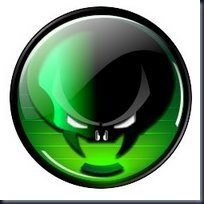 some of the very best aspects of such games as Quake III and Unreal Tournament and wraps them up with a retro alien theme, while adding tons of original ideas to make the game quite unique.
some of the very best aspects of such games as Quake III and Unreal Tournament and wraps them up with a retro alien theme, while adding tons of original ideas to make the game quite unique.
You've seen the screenshots, the videos, now it is time to face the alien invasion head on, armed to the hilt with disruptors, beamguns, and vaporizors. The amount of improvements to the game engine are staggering.
The game comes alive with the full implementation of GLSL per-pixel lighting on all surfaces, OpenAL audio system, and new gameplay features. Optimization was as always, another aspect that we've addressed. No longer does one have to be leary of cranking the settings up, the game plays remarkably faster with the switch to GLSL for per-pixel operations. Alien Arena has transformed into a lean, clean, fragging machine, with stunning visual effects that are usually reserved for commercial titles. This isn't your daddy's Alien Arena - it's not even last year's model, with a host of new and improved maps, sounds and music.
Screenshots of Alien Arena 2009 released
![[alienarena3[3].jpg]](https://lh5.ggpht.com/_SbcV8oS9tVE/SlxPe3kNmDI/AAAAAAAAAQc/i9G9r2vHT_A/s1600/alienarena3%5B3%5D.jpg) 16 screenshots of the upcoming release of Alien Arena 2009 have been released! The engine has received some very signifigant advances, and there is a wealth of new content and arenas for players to battle in. It has been said that the bar has been raised for FOSS games, and Alien Arena 2009 is looking to pull up a stool and order a double shot of Bourbon! We are projecting a release in June, so keep your eyes and ears out for the invasion
16 screenshots of the upcoming release of Alien Arena 2009 have been released! The engine has received some very signifigant advances, and there is a wealth of new content and arenas for players to battle in. It has been said that the bar has been raised for FOSS games, and Alien Arena 2009 is looking to pull up a stool and order a double shot of Bourbon! We are projecting a release in June, so keep your eyes and ears out for the invasion
Some of the new features in this release:
* GLSL per-pixel lighting on meshes(now all surfaces).
* OpenAL 1.1
* Ogg-Vorbis support.
* GLSL post process framebuffer effects.
* New scoreboards.
* New HUD.
* Stereo music files.
* Seven new maps.
* Two new player characters.
* Voice taunt system.
* Doppler sound effects.
Alien Arena 2008 is a free, stand-alone deathmatch game based on source code released by id Software. Begun by COR Entertainment in 2004, the game combines a 1950s-era sci-fi atmosphere with gameplay similar to the Quake, Doom, and Unreal Tournament series. Alien Arena focuses mainly on online multiplayer action, although it does contain single-player campaigns against bots.
This game is the followup to the critically acclaimed Alien Arena 2007, and features nearly all new game media, gameplay improvements, and a client that has been signifigantly upgraded for improved visual effects as well as major optimizations that greatly improve the fluidity and performance.
Alien Arena 2009 also offers a change to it's overall theme, moving towards a slightler darker, more serious tone, while still retaining a good bit of it's retro style, creating an interesting marriage between classic and modern sci-fi. This resulted in completely new player models, many new weapon models and textures, and seventeen, yes, seventeen new levels! The transformation is nothing short of remarkable.
There are major improvements in weapon effects, per-pixel lighting, texture resolution, and resource usage, as well as the addition of a cross platform server browser, FUSE. Weapons have been tweaked for better balance, and movement has been enhanced with the addition of dodging abilities. Alien Arena 2008 will run on Windows and Linux, and the OSX/Mac port will be released in one week.
Alien Arena has been released for Microsoft Windows, Linux and FreeBSD. The game has been free to play since its inception, and there are currently no plans to change it to a pay-to-play format. However, as of October 15, 2008, the latest SVN builds now feature in-game advertising, in the main menu and in some maps. While the game's content is proprietary, the CRX engine is open source.
The game is powered by the id Tech 2-based CRX game engine, which has been heavily rewritten to include support for such features as 32-bit high-resolution textures, 3D models used as architecture in maps, GLSL effects, parallax mapping, rotating particles, server-side antilag code, shaders (GLSL and rscript), textured particles, stain maps, reflective water with refractive shaders, Reflective surfaces on entities and on the first-person perspective of some weapons, semi-true reflective surfaces for computers unable to handle full reflection, light bloom, real-time shadows, overbright bits, real-time vertex lighting, normal mapping, and other modern graphical effects, all of which can be turned on or off in the menu.
The game engine still uses the id Tech 2 BSP format, as well as the id Tech 2 md2 model format. Texture formats supported are:
* .wal files (architecture only.) Can be animated.
* .tga files (both architecture and models.) For a model skin, if files are available in TGA and JPEG format, the game engine will default to TGA.
* .jpg files (both architecture and models.)
Most of the console commands for this game are identical in Quake II.
Gameplay
There are 60 standard maps to choose from, 5 playable characters, and 9 weapons with alternate fires, and a grappling hook. The game features an internal server browser for finding other players online, and the external Code Red Galaxy program performs the same function without having to launch the game, akin to The All-Seeing Eye. It also serves as an IRC client for chat between players.
Alien Arena features several game modes:
* Standard Deathmatch, similar in style to Quake III Arena and Unreal Tournament
* Team Deathmatch
* All Out Assault, normal Deathmatch with vehicles added
* Capture the flag
* Deathball, similar to Unreal Tournament's Bombing Run
* Team Core Assault, a team-based game mode where each team tries to turn off all three of the other team's power nodes and then destroy that team's spider node
* Cattle Prod, a variant that requires players to herd robotic cattle through goals to earn points for their team.
There are also several powerups, all of which expire after a short amount of time.
* Double damage.
* Sproing, a powerup that allows players to jump several times higher than they would normally be able to do.
* Haste, a powerup that allows players to jump forward and dodge at high velocity.
* Invulnerability, a powerup that makes players impervious to damage. This powerup is rarely placed in maps.
* Invisibility, a powerup which applies a glass shader to the player. The effectiveness of this powerup depends largely on the lighting of the map. This is the only powerup in the entire game which cannot be placed in maps (as there is no model for it.)
There are twelve game mutators which can alter the game to play differently. Multiple mutators can be enabled in any combination.
* Excessive, a mutator which causes players to spawn by default with every weapon and full ammo, 300 combined health and armor (which will regenerate back to full,) and very weapon has been made more powerful, either in rate of fire or damage. Player speed is enabled by default when this mutator is enabled.
* Joust, which allows players to continue to jump indefinitely while still in midair, until they reach the top of the map.
* Instagib.
* Rocket Arena, where the player spawns with a rocket launcher and infinite ammo, and all other weapons are disabled.
* Vampire, where one can gain health by damaging someone else.
* Regeneration, where health regenerates slowly until it reaches 100.
* Low Gravity.
* Quick weapons, where one can switch between weapons faster.
* Antilag, which is done in server-side code.
* Anti-camp: if a player stays in the same place for a minimum amount of time (set by the server administrator,) that player begins to get damaged.
* Player speed, where players can move faster.
* Class-based, where robot, human, and alien models each have different abilities.
All modes can be played online against other players or offline against bots. The same can be said for all mutators except for Antilag, which is only playable online.
The bots can be customized using an external program included with the installation of the game.
A rewards system has been added to the most recent version of the game, where points are awarded to a player for certain actions (such as midair shots, gibbing an enemy, and killing sprees.) When a threshold amount of points (set by the server administrator) has been reached, one of three powerups can be chosen: haste, invisibility, or sproing. After the powerup has expired, the player must start accumulating points again.
The game uses modified Quake II physics. Most Quake II trickjumps, such as strafejumping, will work in Alien Arena, as well as dodging. However, due to Alien Arena's modified weapon balance, weapon jumps behave differently than in Quake II. In addition to the rocket launcher, the blaster, disruptor, and beamgun have all been made usable for weapon jumps. Since the blaster is one of the starting weapons, Alien Arena gives players the ability to perform weapon jumps as soon as they spawn. The beamgun is also useful for plasma climbing, a type of trickjump that was introduced in Quake III.
History
As of October 18, 2008, the latest version of the game is version 7.20, the third major release in the Alien Arena 2008 series. This version added a number of graphical effects, such as extensive GLSL support and Parallax mapping, as well as adding a rewards system to the game.
Version 7.10 was the latest version as of June 6, 2008. This update was originally planned as a minor patch to take the game from version 7.00 to 7.01, but was bumped up to a major revision consisting of five revamped maps, two brand new maps, major renderer changes, new gameplay features, and important bugfixes. The developers described it as "what may just well be the most significant milestone in the long history of this game".
Although it had been in development since 2003, Alien Arena was first released as a beta in August 2004, with the title CodeRED: Alien Arena. Two single-player, campaign-style games, CodeRED: Battle for Earth and CodeRED: Martian Chronicles, were released during 2003.Following these games, Alien Arena received greater development focus. The final upgrade to the two single-player games was made available on February 18, 2005.The "CodeRED" title continued to be used until Alien Arena 2006 was released in November of 2005, promoted as a "sequel" to the old CodeRED version. Alien Arena 2007 (CRX version 6.00) was released in September 2006, and Alien Arena 2008 (CRX version 7.00) appeared in March 2008.
Screenshots
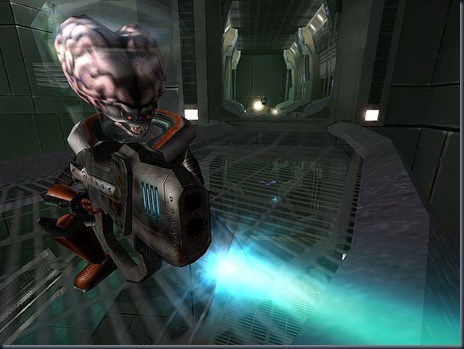
 some of the very best aspects of such games as Quake III and Unreal Tournament and wraps them up with a retro alien theme, while adding tons of original ideas to make the game quite unique.
some of the very best aspects of such games as Quake III and Unreal Tournament and wraps them up with a retro alien theme, while adding tons of original ideas to make the game quite unique. You've seen the screenshots, the videos, now it is time to face the alien invasion head on, armed to the hilt with disruptors, beamguns, and vaporizors. The amount of improvements to the game engine are staggering.
The game comes alive with the full implementation of GLSL per-pixel lighting on all surfaces, OpenAL audio system, and new gameplay features. Optimization was as always, another aspect that we've addressed. No longer does one have to be leary of cranking the settings up, the game plays remarkably faster with the switch to GLSL for per-pixel operations. Alien Arena has transformed into a lean, clean, fragging machine, with stunning visual effects that are usually reserved for commercial titles. This isn't your daddy's Alien Arena - it's not even last year's model, with a host of new and improved maps, sounds and music.
Screenshots of Alien Arena 2009 released
![[alienarena3[3].jpg]](https://lh5.ggpht.com/_SbcV8oS9tVE/SlxPe3kNmDI/AAAAAAAAAQc/i9G9r2vHT_A/s1600/alienarena3%5B3%5D.jpg)
Some of the new features in this release:
* GLSL per-pixel lighting on meshes(now all surfaces).
* OpenAL 1.1
* Ogg-Vorbis support.
* GLSL post process framebuffer effects.
* New scoreboards.
* New HUD.
* Stereo music files.
* Seven new maps.
* Two new player characters.
* Voice taunt system.
* Doppler sound effects.
Alien Arena 2008 is a free, stand-alone deathmatch game based on source code released by id Software. Begun by COR Entertainment in 2004, the game combines a 1950s-era sci-fi atmosphere with gameplay similar to the Quake, Doom, and Unreal Tournament series. Alien Arena focuses mainly on online multiplayer action, although it does contain single-player campaigns against bots.
This game is the followup to the critically acclaimed Alien Arena 2007, and features nearly all new game media, gameplay improvements, and a client that has been signifigantly upgraded for improved visual effects as well as major optimizations that greatly improve the fluidity and performance.
Alien Arena 2009 also offers a change to it's overall theme, moving towards a slightler darker, more serious tone, while still retaining a good bit of it's retro style, creating an interesting marriage between classic and modern sci-fi. This resulted in completely new player models, many new weapon models and textures, and seventeen, yes, seventeen new levels! The transformation is nothing short of remarkable.
There are major improvements in weapon effects, per-pixel lighting, texture resolution, and resource usage, as well as the addition of a cross platform server browser, FUSE. Weapons have been tweaked for better balance, and movement has been enhanced with the addition of dodging abilities. Alien Arena 2008 will run on Windows and Linux, and the OSX/Mac port will be released in one week.
Alien Arena has been released for Microsoft Windows, Linux and FreeBSD. The game has been free to play since its inception, and there are currently no plans to change it to a pay-to-play format. However, as of October 15, 2008, the latest SVN builds now feature in-game advertising, in the main menu and in some maps. While the game's content is proprietary, the CRX engine is open source.
The game is powered by the id Tech 2-based CRX game engine, which has been heavily rewritten to include support for such features as 32-bit high-resolution textures, 3D models used as architecture in maps, GLSL effects, parallax mapping, rotating particles, server-side antilag code, shaders (GLSL and rscript), textured particles, stain maps, reflective water with refractive shaders, Reflective surfaces on entities and on the first-person perspective of some weapons, semi-true reflective surfaces for computers unable to handle full reflection, light bloom, real-time shadows, overbright bits, real-time vertex lighting, normal mapping, and other modern graphical effects, all of which can be turned on or off in the menu.
The game engine still uses the id Tech 2 BSP format, as well as the id Tech 2 md2 model format. Texture formats supported are:
* .wal files (architecture only.) Can be animated.
* .tga files (both architecture and models.) For a model skin, if files are available in TGA and JPEG format, the game engine will default to TGA.
* .jpg files (both architecture and models.)
Most of the console commands for this game are identical in Quake II.
Gameplay
There are 60 standard maps to choose from, 5 playable characters, and 9 weapons with alternate fires, and a grappling hook. The game features an internal server browser for finding other players online, and the external Code Red Galaxy program performs the same function without having to launch the game, akin to The All-Seeing Eye. It also serves as an IRC client for chat between players.
Alien Arena features several game modes:
* Standard Deathmatch, similar in style to Quake III Arena and Unreal Tournament
* Team Deathmatch
* All Out Assault, normal Deathmatch with vehicles added
* Capture the flag
* Deathball, similar to Unreal Tournament's Bombing Run
* Team Core Assault, a team-based game mode where each team tries to turn off all three of the other team's power nodes and then destroy that team's spider node
* Cattle Prod, a variant that requires players to herd robotic cattle through goals to earn points for their team.
There are also several powerups, all of which expire after a short amount of time.
* Double damage.
* Sproing, a powerup that allows players to jump several times higher than they would normally be able to do.
* Haste, a powerup that allows players to jump forward and dodge at high velocity.
* Invulnerability, a powerup that makes players impervious to damage. This powerup is rarely placed in maps.
* Invisibility, a powerup which applies a glass shader to the player. The effectiveness of this powerup depends largely on the lighting of the map. This is the only powerup in the entire game which cannot be placed in maps (as there is no model for it.)
There are twelve game mutators which can alter the game to play differently. Multiple mutators can be enabled in any combination.
* Excessive, a mutator which causes players to spawn by default with every weapon and full ammo, 300 combined health and armor (which will regenerate back to full,) and very weapon has been made more powerful, either in rate of fire or damage. Player speed is enabled by default when this mutator is enabled.
* Joust, which allows players to continue to jump indefinitely while still in midair, until they reach the top of the map.
* Instagib.
* Rocket Arena, where the player spawns with a rocket launcher and infinite ammo, and all other weapons are disabled.
* Vampire, where one can gain health by damaging someone else.
* Regeneration, where health regenerates slowly until it reaches 100.
* Low Gravity.
* Quick weapons, where one can switch between weapons faster.
* Antilag, which is done in server-side code.
* Anti-camp: if a player stays in the same place for a minimum amount of time (set by the server administrator,) that player begins to get damaged.
* Player speed, where players can move faster.
* Class-based, where robot, human, and alien models each have different abilities.
All modes can be played online against other players or offline against bots. The same can be said for all mutators except for Antilag, which is only playable online.
The bots can be customized using an external program included with the installation of the game.
A rewards system has been added to the most recent version of the game, where points are awarded to a player for certain actions (such as midair shots, gibbing an enemy, and killing sprees.) When a threshold amount of points (set by the server administrator) has been reached, one of three powerups can be chosen: haste, invisibility, or sproing. After the powerup has expired, the player must start accumulating points again.
The game uses modified Quake II physics. Most Quake II trickjumps, such as strafejumping, will work in Alien Arena, as well as dodging. However, due to Alien Arena's modified weapon balance, weapon jumps behave differently than in Quake II. In addition to the rocket launcher, the blaster, disruptor, and beamgun have all been made usable for weapon jumps. Since the blaster is one of the starting weapons, Alien Arena gives players the ability to perform weapon jumps as soon as they spawn. The beamgun is also useful for plasma climbing, a type of trickjump that was introduced in Quake III.
History
As of October 18, 2008, the latest version of the game is version 7.20, the third major release in the Alien Arena 2008 series. This version added a number of graphical effects, such as extensive GLSL support and Parallax mapping, as well as adding a rewards system to the game.
Version 7.10 was the latest version as of June 6, 2008. This update was originally planned as a minor patch to take the game from version 7.00 to 7.01, but was bumped up to a major revision consisting of five revamped maps, two brand new maps, major renderer changes, new gameplay features, and important bugfixes. The developers described it as "what may just well be the most significant milestone in the long history of this game".
Although it had been in development since 2003, Alien Arena was first released as a beta in August 2004, with the title CodeRED: Alien Arena. Two single-player, campaign-style games, CodeRED: Battle for Earth and CodeRED: Martian Chronicles, were released during 2003.Following these games, Alien Arena received greater development focus. The final upgrade to the two single-player games was made available on February 18, 2005.The "CodeRED" title continued to be used until Alien Arena 2006 was released in November of 2005, promoted as a "sequel" to the old CodeRED version. Alien Arena 2007 (CRX version 6.00) was released in September 2006, and Alien Arena 2008 (CRX version 7.00) appeared in March 2008.
Screenshots

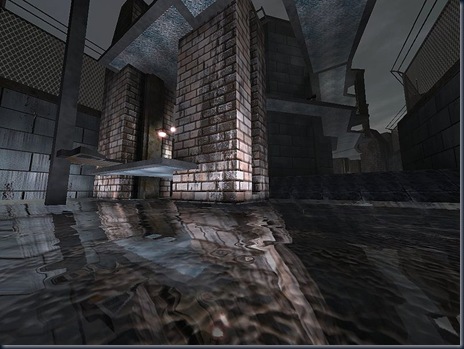
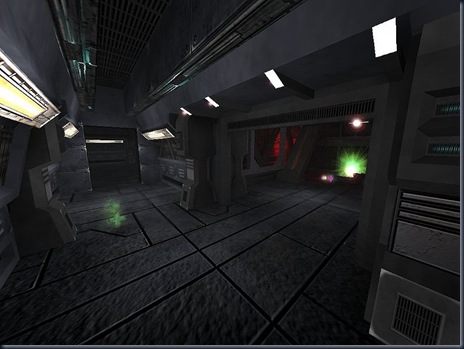
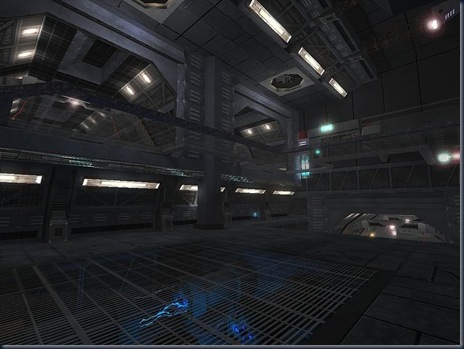
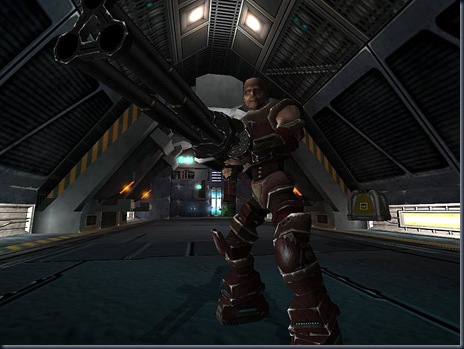

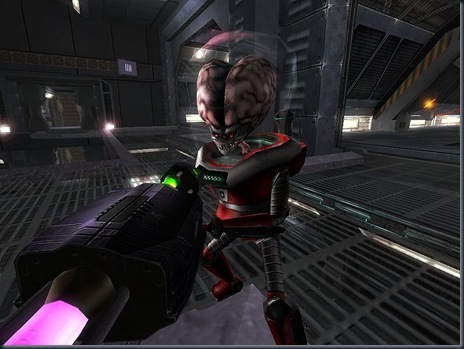

0 commenti:
Post a Comment